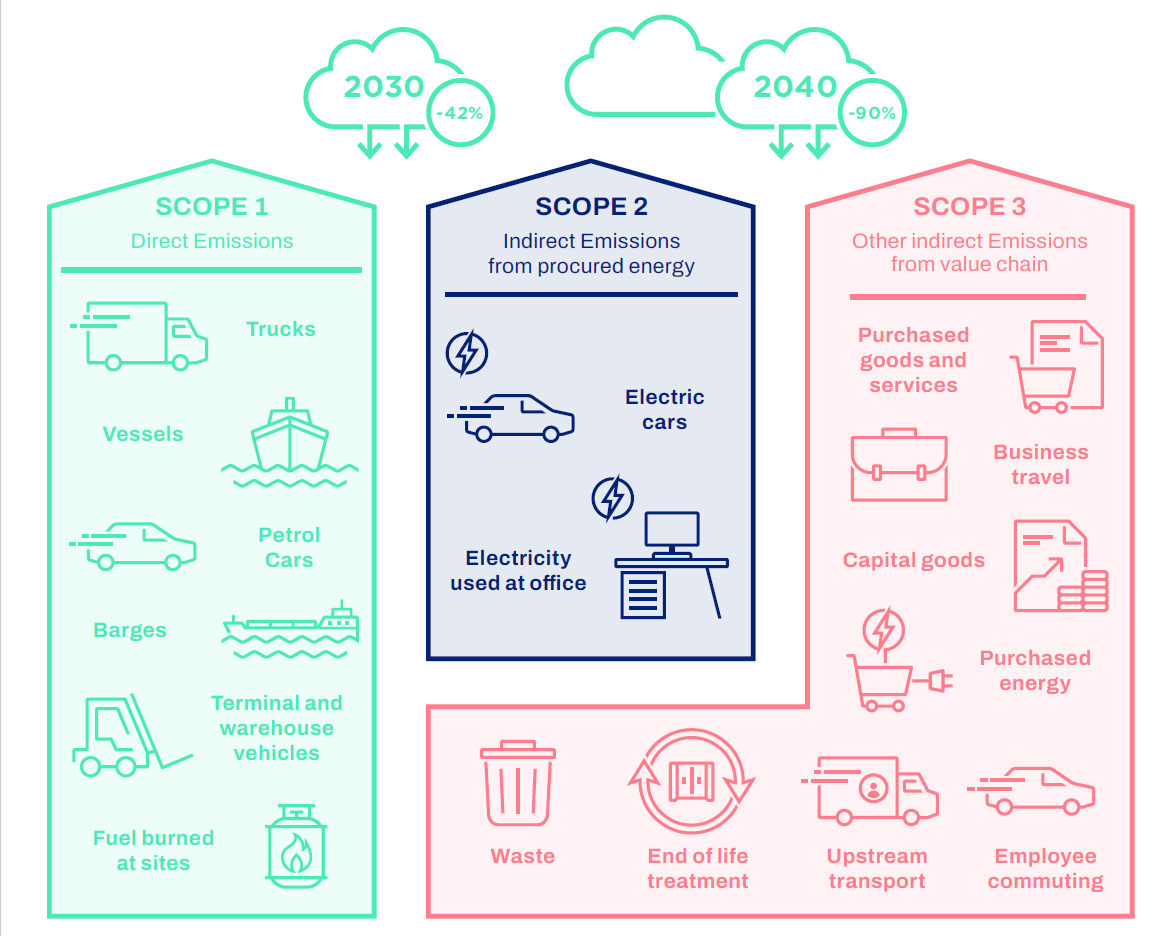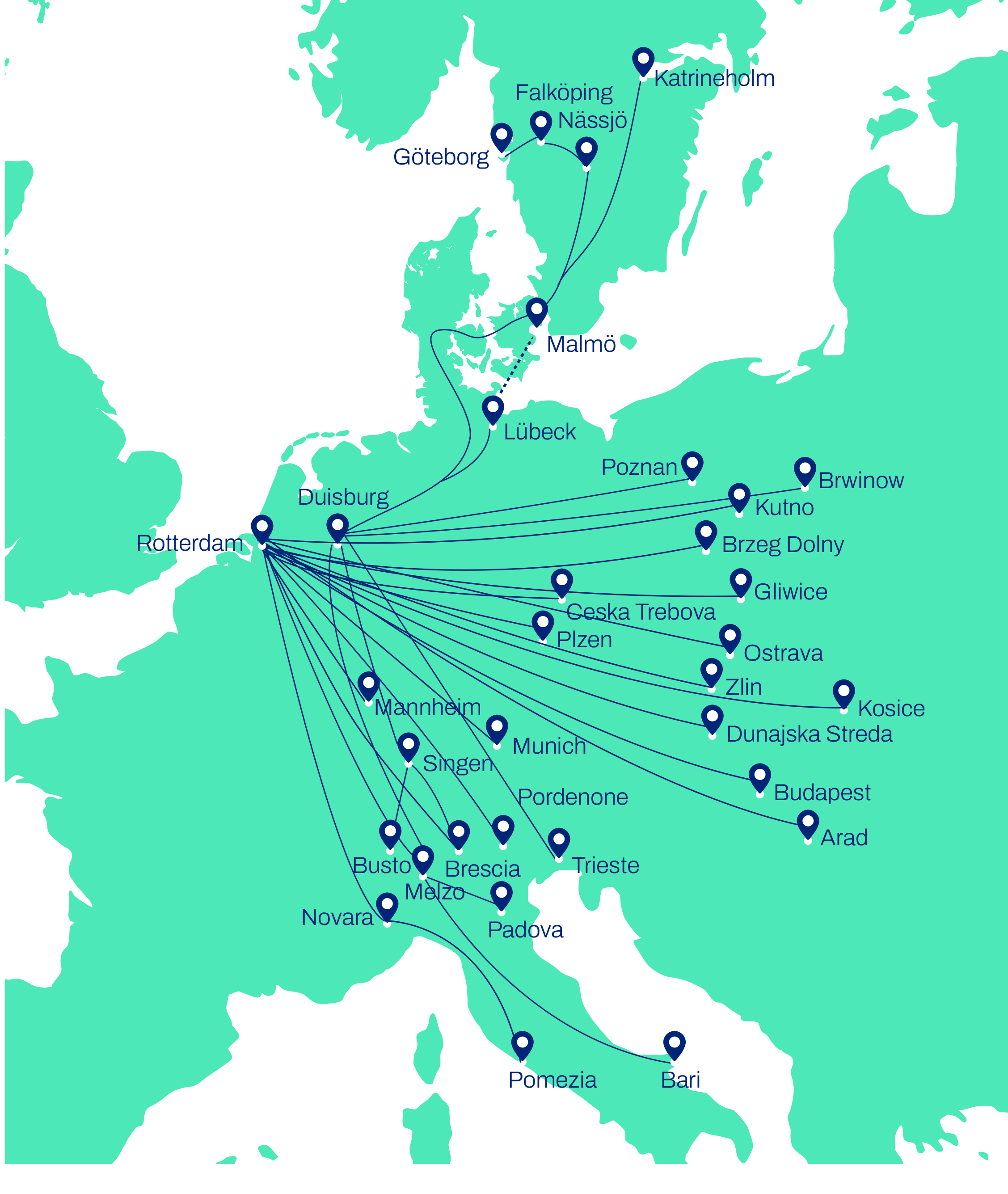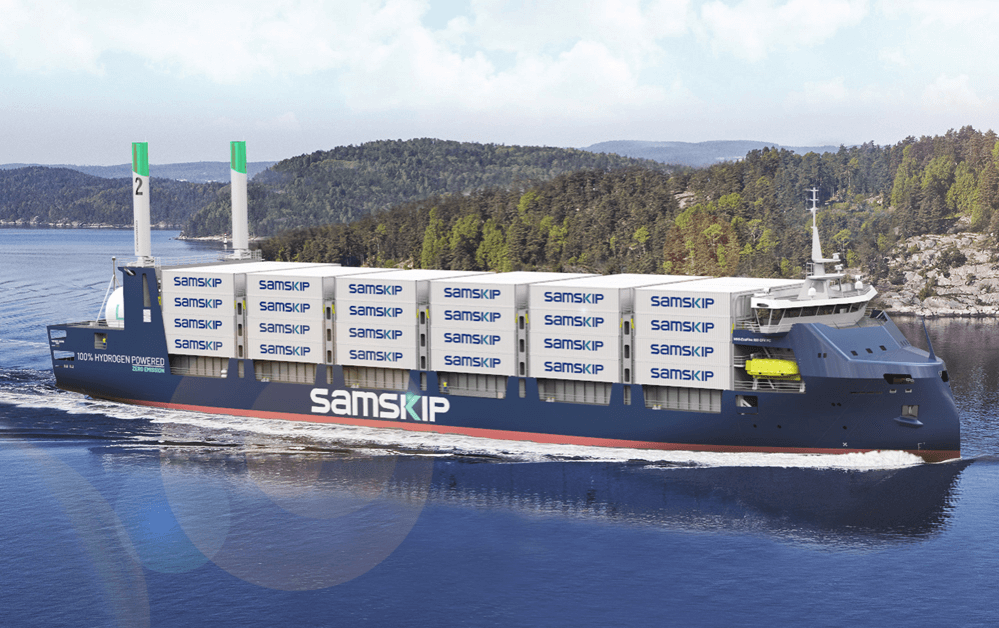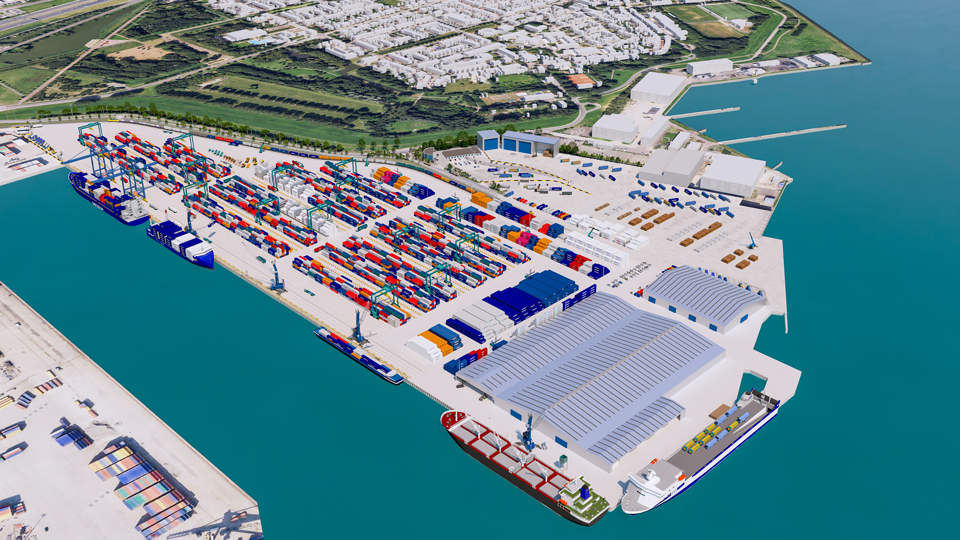

Since 2021, we have been steadfast in our commitment to environmental sustainability, embedding it at the core of our operations.
As a leading multimodal freight transport company, we recognize the urgent need to reduce our environmental impact. We are actively developing strategies to minimize our negative environmental impact, while maximizing our contributions to global initiatives such as the Paris Agreement and the Sustainable Development Goals (SDGs).
Our goal is to inspire positive change in the logistics industry. We recognize that Every Journey Counts. By creating sustainable transport solutions, we are paving the way for a more sustainable future.

(ESRS-E1, GRI-302 and 305, SDG-13)
There’s no silver bullet when it comes to reducing emissions – it takes a combination of solutions, each playing a part. At Samskip, we have an ambitious roadmap with the goal to become carbon neutral by 2040.
We are proactive in addressing climate change, setting ambitious targets, investing in transition strategies, and embracing industry innovations. From adopting biofuels in the short-term to developing the world’s first green hydrogen-fueled vessels, as we continue pushing the boundaries of innovation. But that doesn’t mean there are no compromises to be made. Every choice has its trade-offs. Still, by bringing these actions together, we’re building a connected, realistic roadmap to 2040.
Due to years of commitment and continuous progress reporting, we have positioned ourselves as a leader in sustainable logistics. We’re proud of the work we do with our customers, but also our suppliers.
We can only manage what we measure. That’s why we’ve developed our own carbon calculator, using real fuel consumption data from across the entire Samskip Group. With each region and department owning its data, our global Sustainability Team is in charge of bringing it all together, for a complete picture of our emissions.
Looking at the numbers, our total Scope 1 emissions went up in 2024 compared to the year before. Why? The biggest reason is a drop in the use of marine biofuels, which was replaced by traditional fuel sources. Biofuels have been our go-to interim solution, but this year we chose to shift those resources to something bigger: our upcoming green hydrogen-powered vessels. It’s a trade-off: slightly higher emissions now to invest in major CO₂ savings in the future. We believe it’s the right move for lasting impact.
We also witnessed an increase in our Scope 2 emissions. Throughout 2024, we made significant improvements in the collection of Scope 2 data on a global level, which is reflected in a total increase of Scope 2 emissions. Samskip has an extensive network with different companies and many separate locations. By focusing on better data collection we have included more of these locations this year, which explains the increase in Scope 2 emissions. We did not find any structural drivers of this increase other than our increase in the number of sites included.
Scope 3 emissions were not fully recalculated but based on last year’s figures corrected for business growth or decline. We included significant changes like the capital investments in the SeaShuttles and we updated the amount of procured road transport, which showed a decrease compared to last year.
Some recalculations were applied to Scope 3 emissions in base year 2022 and 2023 as well, to reflect consistency in data allocation. This resulted in a small difference from the values reported in last year’s sustainability report.

.svg)

To measure our global emissions, Samskip has built an internal carbon calculator to guide the way and keep us on track. This system enables us to accurately calculate emissions and assess the effectiveness of our carbon reduction initiatives.
In 2023, we updated our methodology to align with the latest industry standards and began integrating it into our IT systems, including the MySamskip Customer Portal, which enables customers to get clear insights into their emissions. Our approach is fully aligned with the ISO14083 carbon footprinting standards and the GLEC Framework.
To further strengthen our commitment to transparency, Samskip introduced a customized emissions tracking tool in 2023. Built on the rigorous criteria of the SBTi Maritime Guidance and Net-Zero Standard, which are in line with the Global Logistics Emissions Council (GLEC) Framework and Greenhouse Gas (GHG) Protocol. This tool provides a comprehensive view of emissions across our entire company. It allows us to monitor operational emissions and measure the environmental impact of transported shipments with greater accuracy.
All of our carbon reporting is based on the Scope 1, 2 and 3 methodology of the Greenhouse Gas Protocol:
This includes all emissions from our owned and controlled assets using fuels. Throughout the last couple of years, Samskip has been working to reduce its Scope 1 carbon emissions through investments in more sustainable fuel alternatives. Scope 1 is calculated by taking all fuels bought by Samskip, and multiplying it with carbon emission factors per fuel type.
For all indirect emissions that come from the production of the electricity that we use. While the electricity that we use does not emit CO2e, we are responsible for emissions from the production of the electricity that we use. Scope 2 includes data from electricity providers that power the Samskip offices. Previously, we included the electricity usage of our trains in Scope 2, but as Samskip is not buying this energy directly, we’ve decided to include this in Scope 3 from now on.
These indirect emissions from upstream and downstream activities are the most difficult to calculate, and while we stay committed to enhancing data accuracy and transparency across our supply chain, we did not fully recalculate Scope 3 this year as not all categories are material in our total carbon inventory. Samskip estimated its indirect emissions in Scope 3, either through historical proxy data, or spend-based emission factors. Categories like Capital Goods were recalculated and there was a clear difference happening in 2024, also Upstream Transport was updated as it’s the most significant category.









We keep our eyes on the future, and our future is one without emissions. By joining the Science Based Targets initiative (SBTi), Samskip became part of a global network of sustainability leaders committed to real, science-based climate action.
After committing to SBTi in 2023, we developed targets for our operations, including our maritime activities. By end of 2024, we were finally ready: Samskip’s Near-Term and Long-Term targets were officially verified and published on the SBTi website.
The SBTi rigorously reviewed our data, methods, and assumptions, ultimately validating our goals for 2030 and 2040. This means our targets are not just ambitious, they’re aligned with what climate science says is needed to limit global warming to 1.5°C
We based our targets on detailed internal data for Scope 1 and 2 emissions and performed a full Scope 3 screening. Since the maritime sector is an energy-intense sector, the SBTi developed a special Maritime Guidance, which we followed closely. This helped us to construct an additional target for our vessels, alongside our overall targets.
Our near-term (2030) Science-Based Target is to reach at least 42% CO2e reduction, which in our strategic targets we rounded up to 50%. Our long-term (2040) target is to reach Net-Zero emissions, which means we reduce as much CO2e as we can and offset what’s absolutely unavoidable.
As we are including our Scope 3 emissions (indirect emissions from purchased goods and services), we are dependent on our many suppliers. Reaching zero emissions across all these suppliers, alongside our own operations, is incredibly complex, but we are committed: We’re targeting a 90% reduction by 2040.
Since we can’t eliminate every emission across our value chain, the final 10% will be neutralized through high-quality offset projects, like investing in carbon sinks such as forests. Until we reach this 90% reduction, we do not participate in carbon offsetting initiatives but rather invest in our own decarbonization.

Our approach towards Net-Zero emission is built on our Multimodal Network, the standard for energy efficient transport. On top of that, we’re investing heavily in short-term and long-term decarbonization solutions, such as switching to alternative fuels, electrifying our rail network, and the launch of our hydrogen-powered SeaShuttles. Beyond decarbonization, we also take action to prevent and reduce air pollution.
Did you know that Europe is still dominated by road-only transport, even though trucks use about 5 times more energy per container than alternatives via rail and water? By making the switch of transport mode, we can easily reduce carbon emissions by up to 80%.
As our CEO is fond of saying: The greenest form of energy is the energy we can save.
That’s why we focus on reducing energy consumption, through investing in our extensive multimodal system that includes sea-going vessels, river barges, trains, and trucks. Optimizing this network is a must for sustainability. Adding more alternative fuels into an inefficient system would not be sustainable as we would be wasting valuable energy.
With the multimodal network in place, the next step is to target individual assets and begin transitioning fuels. We're transition away from carbon-intensive traditional fuels since back in 2017, when we invested in two Liquefied Natural Gas (LNG) vessels – a bold and innovative decision at the time. As we learned more about alternative fuels, we moved towards marine biofuels as an intermediate solution.
In 2021, Samskip was among the first shipping companies to use 100% biofuels in one of its vessels. When trials succeeded, we increased this to number to five vessels. This helped reduce our vessel fleet’s CO₂e emissions by an estimated 24%, and about 89% per vessel. All our biofuels were, and still are, ISCC certified, with production chains audited on sustainability, deforestation, and competition with food production.
But biofuels are not our end game – they are a transition tool to create impact today. To achieve our Net-Zero target, we must go further. That’s why Samskip is investing in zero-emission technologies, such as our hydrogen-powered Samskip SeaShuttles. These groundbreaking ships will be the world’s first hydrogen short-sea vessels, and are set to embark on their first journey in 2027, marking a significant milestone in maritime decarbonization, and Samskip’s sustainability journey.

2023: 5/41 (Peak of biofuel usage)
2024: Samskip blended biofuels throughout its whole vessel fleet to ensure operational efficiency and compliance with all environmental regulations.

.svg)
Strategy: Pioneer, test, and further develop. Potentially increase the number of hydrogen vessels.
Our robust rail network is one of the cornerstones of our Multimodal Network. Being almost fully electrified – with the exception of some very short repositioning of locomotives within rail stations taking the train is the easiest way to bring emissions close to zero.
In most cases, a container moved by train replaces a journey that would have otherwise been made by truck, helping to significantly cut down on greenhouse gas emissions. For many routes, it’s one of the most effective ways to get close to zero-emission logistics.
In 2023, we expanded our rail network by adding four new routes to our Duisburg terminal, connecting it to Padborg (Denmark), Macon (France), and Padua and Verona (Italy). Duisburg remains a key hub for Samskip's north-south services between Germany, Sweden, and Italy, as well as connecting Denmark, Lubeck, Poland, and our shortsea connections in Rotterdam and Amsterdam. These new routes address the growing driver shortages in Europe's road haulage sector, offering reliable, efficient, and sustainable rail services along major European corridors.

In July 2023, Rotterdam Shortsea Terminals (RST) and Samskip launched the Green Shore Power initiative – aiming to drastically cut CO₂e emissions from docked vessels by providing a clean, innovative onshore power supply.
Previously, vessels relied on fossil fuels to generate electricity while docked. With the implementation of green shore-power, the shipping industry can reduce CO₂ emissions by up to 5 megatons annually, accounting for 3.7% of global shipping emissions.[7] This initiative not only reinforced Samskip’s position as a leader in the industry, but also prepared us for the FuelEU Maritime regulation, which will require shore-power connections by 2030.
We firmly believe that collaborative action is essential to address the urgent challenge of global climate change. We take pride in being early adopters of initiatives like this, positioning ourselves ahead of the industry curve.
For more information: RST and Samskip join forces to launch first shore power green initiative

In 2024, the total energy consumption across our vessels, trucks, barges, trains, offices, and warehouses was (4.22 petajoules), marking a 22.51% increase compared to a 2.03% decrease from 2022 to 2023. The significant increase in energy usage is a result of the introduction of more and larger vessels into our fleet.
While Samskip still is largely dependent on fossil fuels, Samskip also uses renewable biofuels for part of its vessel and truck fleets, alongside renewable electricity for a significant share of its trains and offices. In total, 5% of our energy consumption comes from renewable sources. This represents a 19% decrease from 2023. While our renewable share has declined in the short term, we remain committed to learning from our set backs we can continue to improve in these areas in the future.

By switching to cleaner fuels, as well as complying with local environmental regulations, we achieve reductions in both GHG emissions and local air pollution. We take it a step further by using EGCS
It is important to distinguish the difference between emissions and pollutants, as the terms are often used interchangeably. While both emissions and pollutants can stem from the same transport operations, their impact is different. GHG emissions contribute to rising temperatures at a global level, which in turn affects regions and local communities in various ways. Air pollutants, such as sulfur oxides (SOₓ), nitrogen oxides (NOₓ) have a local impact, directly affecting the air quality and posing health risks to people in the nearby areas.
Samskip recognizes its involvement and actively implements measures to reduce its contribution to operational pollution. We have installed pollution control technologies such as Exhaust Gas Cleaning Systems (EGCS), and invest in sustainable infrastructure, including Shore Power Systems, to minimize our environmental impact.
Next to this, we proactively manage environmental risks through our robust Sustainability Management System. By ensuring strict regulatory compliance and continuously enhancing our sustainability initiatives, we mitigate these risks. All the while safeguarding our business continuity and protecting our customers' interests.
Even though we are fully compliant with all global and local regulations, Samskip’s operations still contribute to local air pollution. Air pollution data is based on fuel data, based on the different fuel types Samskip uses in its vessels and trucks.



The International Maritime Organization (IMO) regulates Sulphur Oxide (SOx) emissions from ships, offering two major compliance options: using fuels with limited sulfur content, or employing EGCS. As of January 1, 2020, the IMO placed a global sulfur cap on fuels, which caused a 77% drop in SOx emissions[8].
At the same time, EGCSs have proven to be effective in removing SOx and other harmful air emissions, like Particulate Matter (PM) and Polycyclic Aromatic Hydrocarbons (PAHs). Therefore, to reduce the emissions of harmful air pollutants, Samskip has equipped 4 ships in 2023 with EGCS, these ships are still in operation with this technology in 2024


The “steel-cutting ceremony” marked the official start of construction for Samskip’s next-generation zero-emission shortsea container vessels: the Samskip SeaShuttles. Construction began March 2023 at the shipyard in India. These vessels are set to become the world’s first zero-emission shortsea container ships using green hydrogen as source of power.
The “steel-cutting ceremony” marked the official start of construction for Samskip’s next-generation zero-emission shortsea container vessels: the Samskip SeaShuttles. Construction began March 2023 at the shipyard in India. These vessels are set to become the world’s first zero-emission shortsea container ships using green hydrogen as source of power.
Each 135-meter vessel will be equipped with a 3.2 MW hydrogen fuel cell, supplemented by (bio)fuel generators for backup power. When operating in zero-emission mode, the two SeaShuttle vessels are projected to reduce CO₂e emissions by approximately 25,000 tons annually. Additionally, they will achieve emission-free operations in ports by utilizing green shore power at their docking locations. Both vessels are scheduled for delivery in 2027.


Samskip, in collaboration with Matrans Rotterdam Terminal, is launching a state-of-the-art terminal in Rotterdam. As a key multimodal hub in Samskip’s network, Rotterdam has long been integral to our operations. This new terminal represents a significant step forward in enhancing reliability, optimizing supply chain efficiency, and advancing sustainable transport solutions.
The terminal will serve as a central hub for both containerized and breakbulk transport, integrating sustainable initiatives such as vehicle electrification, shore power, and solar energy. By improving control over vessel, rail, and barge operations, Samskip aims to reduce bottlenecks, optimize modal shifts, and lower emissions across the supply chain. Digital innovations will further enhance operational efficiency by enabling real-time cargo prioritization and dynamic supply chain management.
Through this initiative, Samskip and Matrans reaffirm their shared vision of a greener, more resilient logistics network, ensuring faster, more reliable transit times with the lowest possible environmental impact.
